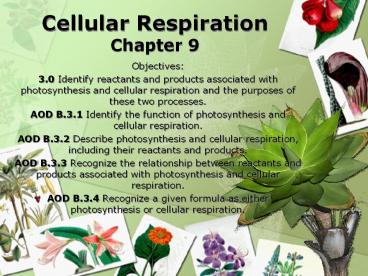Cellular Respiration Chapter 9 - PowerPoint PPT Presentation
Title:
Cellular Respiration Chapter 9
Description:
Chapter 9 Objectives: 3.0 Identify reactants and products associated with photosynthesis and cellular respiration and the purposes of these two processes. – PowerPoint PPT presentation
Number of Views:426
Avg rating:3.0/5.0
Title: Cellular Respiration Chapter 9
1
Cellular RespirationChapter 9
- Objectives
- 3.0 Identify reactants and products associated
with photosynthesis and cellular respiration and
the purposes of these two processes. - AOD B.3.1 Identify the function of photosynthesis
and cellular respiration. - AOD B.3.2 Describe photosynthesis and cellular
respiration, including their reactants and
products. - AOD B.3.3 Recognize the relationship between
reactants and products associated with
photosynthesis and cellular respiration. - AOD B.3.4 Recognize a given formula as either
photosynthesis or cellular respiration.
2
Overview
- Fill in the major steps in cellular respiration
while watching the following video clip
http//www.youtube.com/watch?vaXC9jMNIRnE
3
Section 9-1
- What is the function of the mitochondria?
- What types of cells contain mitochondria?
- All eukaryotic cells
Source http//adamsewall.com/blog/happy-mitochond
ria-happy-gonads/629/
4
- Mitochondria release the energy from glucose and
other food compounds. - Step 1 Glycolysis
- Step 2
- If glycolysis takes place in the presence of
oxygen, then the Krebs cycle and electron
transport chain work to produce lots of ATP. - Without oxygen, fermentation occurs.
5
Cellular Respiration
- Made up of all three processes glycolysis,
Krebs cycle, and electron transport chain - Occurs in the presence of oxygen
- C6H12O6 6O2 6CO2 6H2O
energy - Glucose, if converted all at once, would set the
cells on fire!
6
Glycolysis
- Breaks 1 glucose molecule in half, producing 2
molecules of pyruvic acid (a 6-carbon molecule
becomes 2 3-carbon molecules). - Requires 2 molecules of ATP to break the glucose
molecule. - At the end, the cell will have 4 ATP molecules
--- a gain of 2 ?
7
NADH Production in Glycolysis
- 4 high-energy electrons and 2 Hs attach to 2
electron carriers called NAD (comparable to
NADP in photosynthesis), converting it into
NADH. - Glysolysis yields low energy amounts, but
extremely rapidly, and with or without oxygen.
8
Overview/Review
http//faculty.clintoncc.suny.edu/faculty/michael.
gregory/files/bio20101/bio2010120lectures/cellu
lar20respiration/cellular.htm
9
Fermentation (Anaerobic Respiration)
- Releases energy from food particles by producing
ATP in the absence of oxygen. - Cells convert NADH back to NAD by passing
electrons back to pyruvic acid. This allows
glycolysis to continue producing ATP.
10
2 Types of Fermentation
- Alcoholic fermentation
- Yields ethyl alcohol and CO2
- Pyruvic acid NADH alcohol CO2
NAD - What types of cells?
- Lactic acid fermentation
- Yields lactic acid
- Pyruvic acid NADH lactic acid
NAD - What types of cells?
11
Bellringer/Assessment
- Refer to the Overview/Review for glycolysis,
and Figures 9-3 and 9-4, as needed, to create a
simple flowchart for - Glycolysis
- Alcoholic fermentation
- Lactic acid fermentation
- (Remember, flowchart instructions/example are
found on p.1065)
12
Section 9-2
- What are the waste products of cellular
respiration? - How do we get rid of these waste products?
- Quick Lab How does exercise affect disposal of
wastes from cellular respiration? (p.231)
13
Section 9-2
- The aerobic (in air or oxygen) pathway after
glycolysis consists of 2 main portions - The Krebs cycle
- The electron transport chain
14
Krebs Cycle
- Discovered by Hans Krebs in 1937.
- Breaks pyruvic acid (from where???) into
(ultimately) carbon dioxide
15
Krebs Cycle Steps
- Pyruvic acid enters the mitochondrion.
- One carbon atom breaks off and forms carbon
dioxide. The other 2 carbon atoms, 1 oxygen atom,
and 3 hydrogen atoms form an acetyl group that
attaches to coenzyme A to form acetyl-CoA.
16
Krebs Cycle Steps
- Acetyl-CoA adds the acetyl group to a 4-carbon
molecule, forming a 6-carbon citric acid
molecule. (This is why it is also called the
citric acid cycle.) - 2 carbons are removed (individually) to form CO2,
and electrons are added to energy carrier
molecules (???).
17
Krebs Cycle Steps
- After 2 carbons have been removed, how many
carbons are left? - This 4-carbon molecule is now ready to accept
another acetyl group.
18
Krebs Cycle Steps
- 6. For each cycle, an ATP molecule is produced
--- as citric acid is being reduced to a 4-carbon
molecule. - 7. Additionally, 5 pairs of high-energy electrons
are transferred to electron carriers, changing
NAD to ??? and FAD to FADH2.
19
Krebs Cycle Products
- CO2
- ATP
- NADH and FADH2
- What happens to each of these products?
20
Electron Transport Chain
- So what do you think happens here?
- Electrons from the Krebs cycle are used to
convert ADP to ATP. - How do electrons get from the Krebs cycle to the
transport chain? - Attached to NADH and FADH2 ?
21
- NADH and FADH2 release Hs and electrons.
- The electrons are passed down the transport chain
until they join with oxygen and Hs to form
water (H2O). - Every time 2 electrons are transported down the
chain, a H is transported across the membrane.
22
- How do the Hs generate energy for the cell?
- They cross ATP synthase to reestablish an
equilibrium of charges, and convert ADP to ATP. - They join with oxygen and electrons to form water
(H2O). - What happens to the NADH and FADH2?
- Converted to NAD and FAD to be reused
(where????).
23
Total Production
- Glycolysis 2 ATP
- This is ALL the ATP produced without oxygen.
- WITH oxygen
- Krebs cycle electron transport chain 34 ATP
- Total 36 ATP ---- 18x more than anaerobic
respiration!!!!
24
Comparing Photosynthesis and Cellular Respiration
Photosynthesis Cellular Respiration
Function
Location
Reactants
Products
Equation































